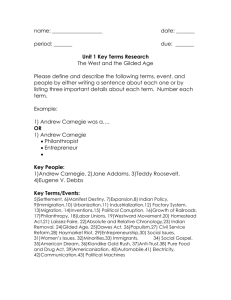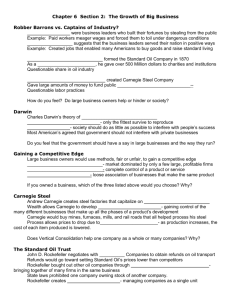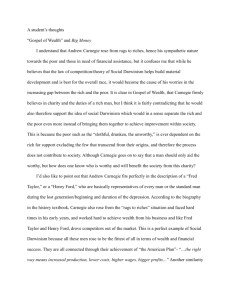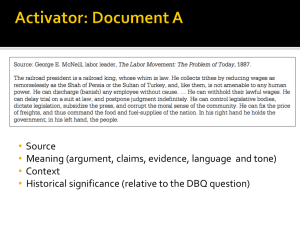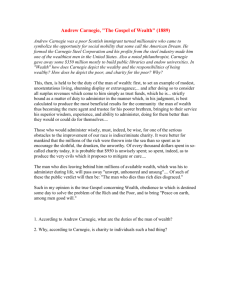Andrew Carnegie and John D. Rockefeller: Captains of Industry (HA)
advertisement
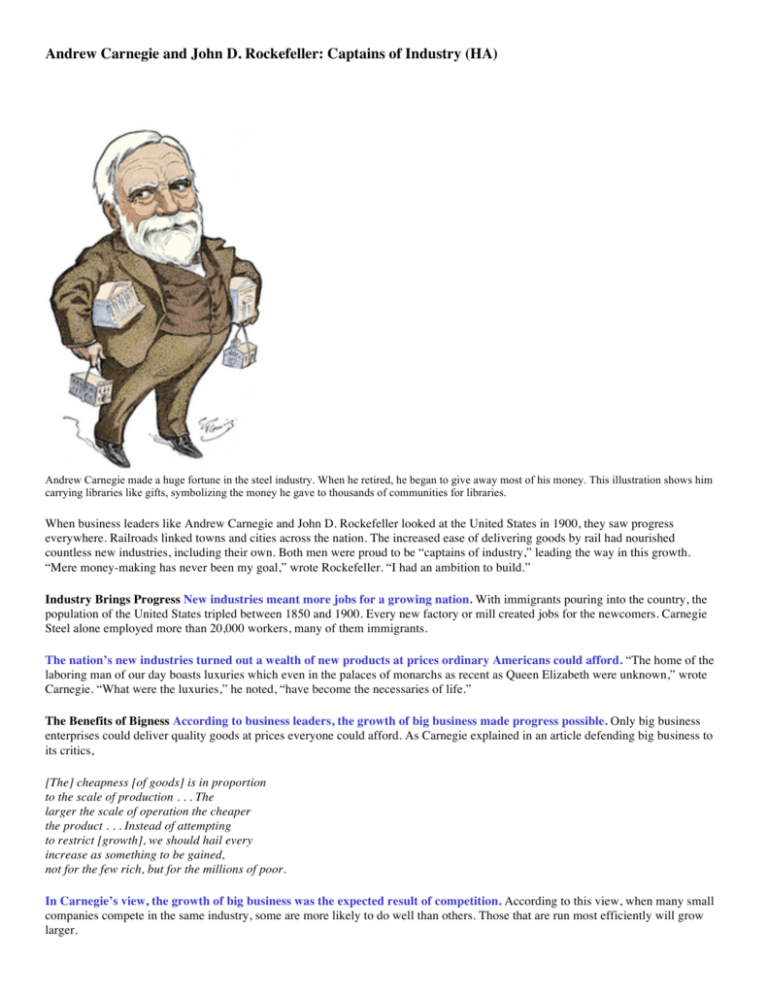
Andrew Carnegie and John D. Rockefeller: Captains of Industry (HA) Andrew Carnegie made a huge fortune in the steel industry. When he retired, he began to give away most of his money. This illustration shows him carrying libraries like gifts, symbolizing the money he gave to thousands of communities for libraries. When business leaders like Andrew Carnegie and John D. Rockefeller looked at the United States in 1900, they saw progress everywhere. Railroads linked towns and cities across the nation. The increased ease of delivering goods by rail had nourished countless new industries, including their own. Both men were proud to be “captains of industry,” leading the way in this growth. “Mere money-making has never been my goal,” wrote Rockefeller. “I had an ambition to build.” Industry Brings Progress New industries meant more jobs for a growing nation. With immigrants pouring into the country, the population of the United States tripled between 1850 and 1900. Every new factory or mill created jobs for the newcomers. Carnegie Steel alone employed more than 20,000 workers, many of them immigrants. The nation’s new industries turned out a wealth of new products at prices ordinary Americans could afford. “The home of the laboring man of our day boasts luxuries which even in the palaces of monarchs as recent as Queen Elizabeth were unknown,” wrote Carnegie. “What were the luxuries,” he noted, “have become the necessaries of life.” The Benefits of Bigness According to business leaders, the growth of big business made progress possible. Only big business enterprises could deliver quality goods at prices everyone could afford. As Carnegie explained in an article defending big business to its critics, [The] cheapness [of goods] is in proportion to the scale of production . . . The larger the scale of operation the cheaper the product . . . Instead of attempting to restrict [growth], we should hail every increase as something to be gained, not for the few rich, but for the millions of poor. In Carnegie’s view, the growth of big business was the expected result of competition. According to this view, when many small companies compete in the same industry, some are more likely to do well than others. Those that are run most efficiently will grow larger. Those that are not well run will perish. “The law of competition,” Carnegie argued, “may be sometimes hard for the individual, [but] it is best for the race, because it ensures the survival of the fittest in every department.” When Carnegie wrote about “the law of competition” in business, he was borrowing an idea from the British naturalist Charles Darwin. Darwin had observed that, in nature, animals and plants compete for food and living space. Those that are best adapted to their environments are the most likely to survive. This idea was popularized as “survival of the fittest.” Before long, some people began to apply Darwin’s idea to human society. The result was social Darwinism [social Darwinism: the theory that people and societies compete for survival, with the fit becoming wealthy and successful while the weak struggle to survive] . According to this theory, people and societies compete for survival just as plants and animals do. The most fit become wealthy and successful. The least fit struggle just to survive. John D. Rockefeller’s Standard Oil Company controlled 90 percent of the oil refined in the United States at the start of the 20th century. His business methods were considered ruthless by his critics, and brilliant by his supporters. Social Darwinism seemed to provide a “scientific” justification for huge differences in people’s wealth and power. It also lent support to the economic concept of laissez-faire, the idea that businesses should operate with a minimum of government interference. The best possible economy will then emerge naturally. By this line of thinking, it is misguided for government to try to correct such problems as child labor, poor working conditions, and unfair business practices. Giving Away Wealth In 1901, Andrew Carnegie sold his steel company for $250 million. Then he retired to devote his life to philanthropy, or generosity to charities. Carnegie believed that rich people have a responsibility to use their wealth to help others. “He who dies rich,” he wrote, “dies disgraced.” Carnegie used his wealth to build concert halls, universities, and hospitals. Most of all, however, he loved building libraries. A library, he said, “outranks any other one thing that a community can do to benefit its people.” Before 1880, few Americans had access to free public libraries. Just one generation later, 35 million people a day were using libraries that Carnegie had helped to build. “Your example will bear fruits,” John D. Rockefeller wrote to Carnegie. “The time will come when men of wealth will more generally be willing to use it for the good of others.” Rockefeller used his own fortune to fund universities, medical research, the arts, and education for all. During his lifetime, he contributed about $182 million to the Rockefeller Foundation, a charitable organization he established to promote “the well-being of mankind throughout the world.”

